alibaba sentinel限流组件 源码分析
如何使用?
maven引入:
<dependency>
<groupId>com.alibaba.csp</groupId>
<artifactId>sentinel-core</artifactId>
<version>1.5.1</version>
</dependency>
该组件是保护资源用,什么资源呢?Conceptually, physical or logical resource,明白了吧。
web应用中大部分情况都是用于保护接口,防止负载过大,支持限流、降级处理,规则可配。
入门级使用方法如下:
public void foo() { Entry entry = null; try { entry = SphU.entry("abc"); // resource that need protection } catch (BlockException blockException) { // when goes there, it is blocked // add blocked handle logic here } catch (Throwable bizException) { // business exception Tracer.trace(bizException); } finally { // ensure finally be executed if (entry != null){ entry.exit(); } } }
或者
public void foo() {
if (SphO.entry("abc")) {
try {
// business logic
} finally {
SphO.exit(); // must exit()
}
} else {
// failed to enter the protected resource.
}
}
入口为com.alibaba.csp.sentinel.SphU和com.alibaba.csp.sentinel.SphO。两者的区别从使用就可以看出,限流发生时,SphU是通过异常的形式反馈出来,SphO是通过entry的返回值反馈出来的。
查看SphO的代码,如下图,其实是内部捕获了异常,然后返回boolean类型。所以,我们就从SphU开始分析吧。

SphU
最终会调用到com.alibaba.csp.sentinel.CtSph.entryWithPriority(ResourceWrapper, int, boolean, Object...)这个方法。
里面的核心为调用com.alibaba.csp.sentinel.CtSph.lookProcessChain(ResourceWrapper)获取对应的处理链,方法如下:
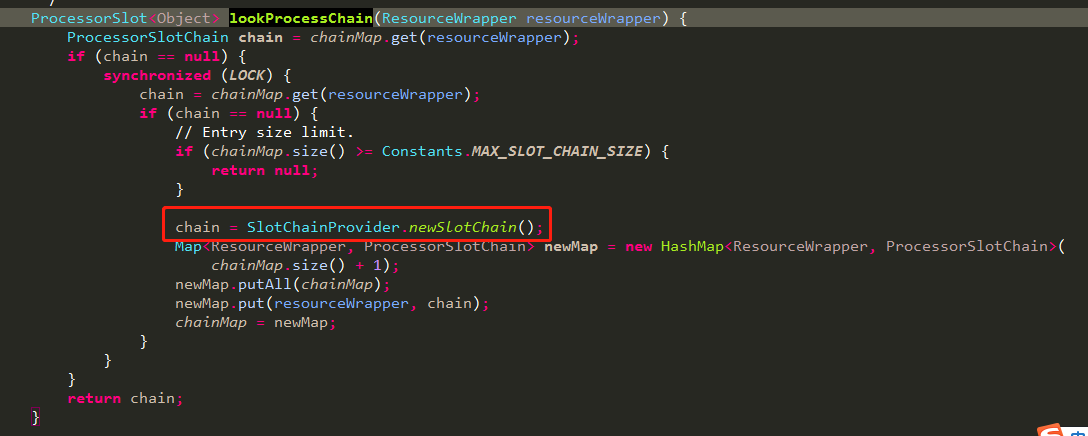
从上面代码可知,一个chain关联一个资源,这一点很重要,后面分析node节点结构时会用到。
public static ProcessorSlotChain newSlotChain() { if (builder != null) { return builder.build(); } // 构建chainBuilder,具体说明见下面代码 resolveSlotChainBuilder(); if (builder == null) { RecordLog.warn("[SlotChainProvider] Wrong state when resolving slot chain builder, using default"); builder = new DefaultSlotChainBuilder(); } return builder.build(); } private static void resolveSlotChainBuilder() { List<SlotChainBuilder> list = new ArrayList<SlotChainBuilder>(); boolean hasOther = false;
// java.util.ServiceLoader 方式扩展功能,这是jdk的,简称spi扩展,sentinel有很多地方用到这种扩展方式
// 关于ServiceLoader扩展的详解不在这里讨论,后面有时间可以单独拎出来分析下
for (SlotChainBuilder builder : LOADER) { if (builder.getClass() != DefaultSlotChainBuilder.class) { hasOther = true; list.add(builder); } } if (hasOther) { builder = list.get(0); } else { // No custom builder, using default. builder = new DefaultSlotChainBuilder(); } RecordLog.info("[SlotChainProvider] Global slot chain builder resolved: " + builder.getClass().getCanonicalName()); }
通过上面代码可知,一般情况下采用的默认chainBuilder,那我们就来看看这个build:
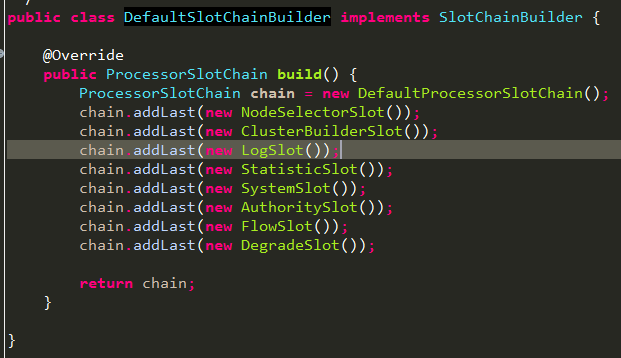
通过上面com.alibaba.csp.sentinel.CtSph.entryWithPriority(ResourceWrapper, int, boolean, Object...)方法可知,最终调用方式如下:

通过entry调用把chain中的所有ProcessorSlot串起来,挨个调用。
主体已经清晰了,重点其实也就是chain中添加的那些ProcessorSlot,下面我们就一个个看下这些slot到底干了啥,划下重点,StatisticSlot这个slot是核心,用于统计各种数量。
NodeSelectorSlot
构建调用资源调用路径,最终在内存中会形成一个树状结构。
ContextUtil.enter("entrance1", "appA");
Entry nodeA = SphU.entry("nodeA");
if (nodeA != null) {
nodeA.exit();
}
ContextUtil.exit();
上述代码对象结构如下:
machine-root
/
/
EntranceNode1
/
/
DefaultNode(nodeA)- - - - - -> ClusterNode(nodeA);
ContextUtil.enter("entrance1", "appA");
Entry nodeA = SphU.entry("nodeA");
if (nodeA != null) {
nodeA.exit();
}
ContextUtil.exit();
ContextUtil.enter("entrance2", "appA");
nodeA = SphU.entry("nodeA");
if (nodeA != null) {
nodeA.exit();
}
ContextUtil.exit();
上述代码会形成结构如下:
machine-root
/ \
/ \
EntranceNode1 EntranceNode2
/ \
/ \
DefaultNode(nodeA) DefaultNode(nodeA)
| |
+- - - - - - - - - - +- - - - - - -> ClusterNode(nodeA);
ContextUtil.enter("entrance1", "appA");
Entry nodeA = null;
try {
nodeA = SphU.entry("nodeA");
Entry nodeB = null;
try {
nodeB = SphU.entry("nodeB");
}finally {
if (nodeB != null) {
nodeB.exit();
}
}
}finally {
if (nodeA != null) {
nodeA.exit();
}
}
ContextUtil.exit();
上述代码会形成结构如下:
machine-root
/
/
EntranceNode1
/
/
DefaultNode(nodeA) - - - - - -> ClusterNode(nodeA);
/
/
DefaultNode(nodeB)- - - - - -> ClusterNode(nodeB);
说明:
a.一条路径对应一个Context;如果是入门的那种使用方法,即没有显式使用ContextUtil.enter("entrance1", "appA")方式创建context的话,会默认使用MyContextUtil.myEnter创建一个名为sentinel_default_context的context;
源码释义:
一次资源的访问都会走到com.alibaba.csp.sentinel.CtSph.entryWithPriority(ResourceWrapper, int, boolean, Object...),方法开始处通过ContextUtil.getContext()从threadlocal中获取context,ContextUtil.enter会检查threadlocal有没有context,没有就创建,有就直接返回。如果限流时没有调用ContextUtil.enter显式开启context,就会走到下面MyContextUtil.myEnter处创建默认名为


b.一次资源的调用会根据threadlocal获取Context,同一线程下如果要切换context必须调用ContextUtil.exit();结束上一个context,再ContextUtil.enter("entrance2", "appA")开启新的context;
源码释义:
context的获取见上面一条释义,这里看下ContextUtil.exit()方法,要想真正的将threadlocal清空,还得将context的CurEntry清空,怎么做?就是按照entry的调用顺序反向依次调用com.alibaba.csp.sentinel.CtEntry.exit(int, Object...):

c.一个DefaultNode对应同一个资源调用在某一个Context下的统计数据;
源码释义:
首先,一次资源的entry调用会先去寻找ProcessorSlotChain,查看代码可知,chain是以ResourceWrapper为key缓存在map中的,由DefaultSlotChainBuilder可以对应到一次entry调用对应一个NodeSelectorSlot实例,而NodeSelectorSlot中缓存了一个以contextName为key,DefaultNode为value的map,一句话总结下就是先去com.alibaba.csp.sentinel.context.ContextUtil.trueEnter(String, String)方法中通过contextNameNodeMap获取以contextName缓存的该name对应的EntranceNode节点并以该EntranceNode为参数new一个context对象返回,然后在该资源对应的slotChain中的NodeSelectorSlot获取一contextName为key缓存的DefaultNode。
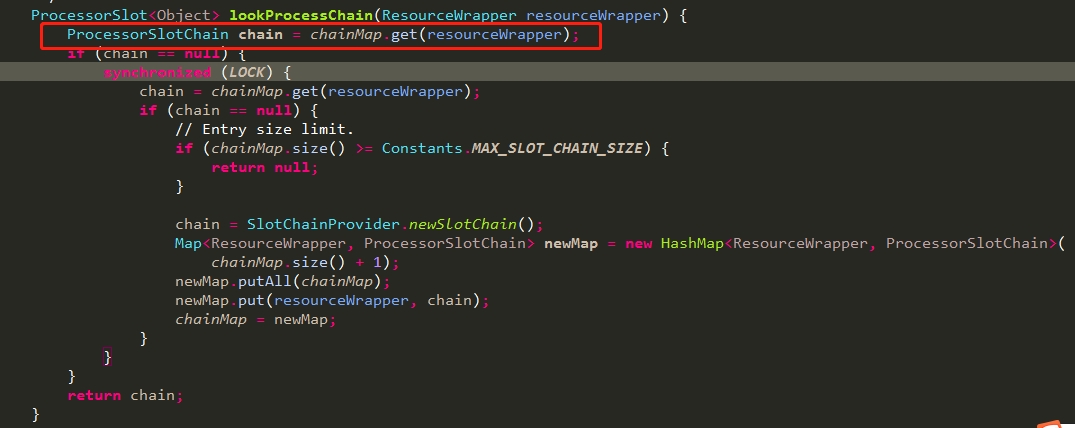
这里解释下DefaultNode第一次是怎么挂到context的EntranceNode下的。
代码如下,重点是红框中的代码,获取context中最末尾的节点,并把当前节点挂在后面。

我们再看下context的getLastNode节点,代码如下:

由上面代码自然会想的curEntry是什么时候设置的呢?如下图所示,是在com.alibaba.csp.sentinel.CtSph.entryWithPriority(ResourceWrapper, int, boolean, Object...)中构建CtEntry时设置的,entry之间的关系在context中是以双向链表结构维护的:
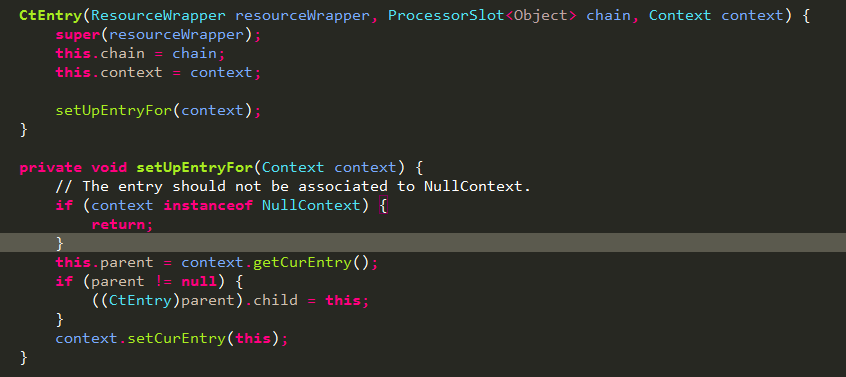
回到上一步,我们看下entry的getLastNode方法,如下图所示,从parentEntry中获取curNode,如果是第一次调用的话parent肯定为null,回到上一步的话就是返回该context的entranceNode。

NodeSelectorSlot中就会将当次entry在该context下首次调用创建的DefaultNode挂到刚刚获取到的entranceNode节点下,也就是该context的入口节点下,如果该context下之前有过别的资源调用,就会顺序挂到那次调用产生的DefaultNode下面,形成上面描述的树状结构图。

DefaultNode处理完后会将context的CurNode设置为该DefaultNode,如下图所示:
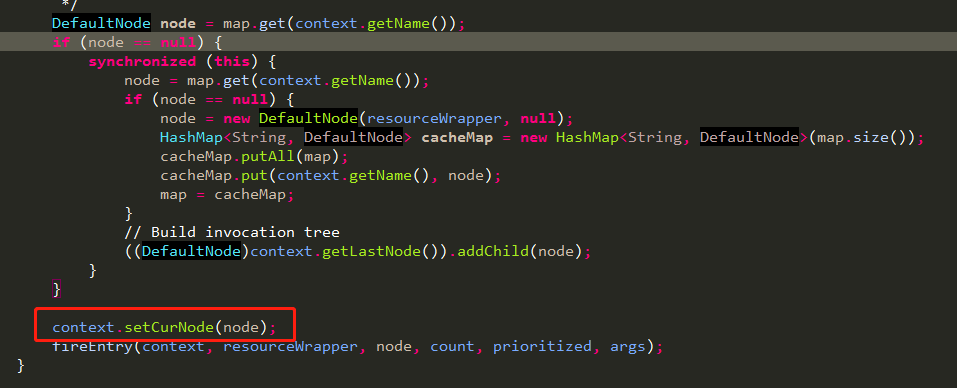
实际上是设置的context中当前entry对应的CurNode,如下图所示,所以上面getLastNode是从parenEntry中获取的CurNode。

d.ClusterNode对应同一个资源在所有context下的统计数据;
源码释义:
ClusterBuilderSlot中维护的一个实例变量实际就是对应一个资源,原因上面已经分析了,一个资源对应一个slotChain,然后将该clusterNode设置到本次调用对应的DefaultNode中,在DefaultNode做加法操作时,会同时调用clusterNode的加法操作,这样,分布在不同context下的同一个资源对应的所有DefaultNode都会去调用clusterNode去汇总统计相同资源的统计数据。

e.一个资源对应一个ProcessChain,自然就对应一个NodeSelectorSlot实例,所以在NodeSelectorSlot里面DefaultNode node = map.get(context.getName());这行代码的一维是资源,二维才是context,如果搞反了可能看到这行会蒙圈;
源码释义:
见c的分析。
ClusterBuilderSlot
构建ClusterNode并设置到上面slot选中的node中,如果context中有设置调用来源Origin就创建一个StatisticNode针对具体某个调用方统计数据
Note that 'origin' usually is Service Consumer's app name:
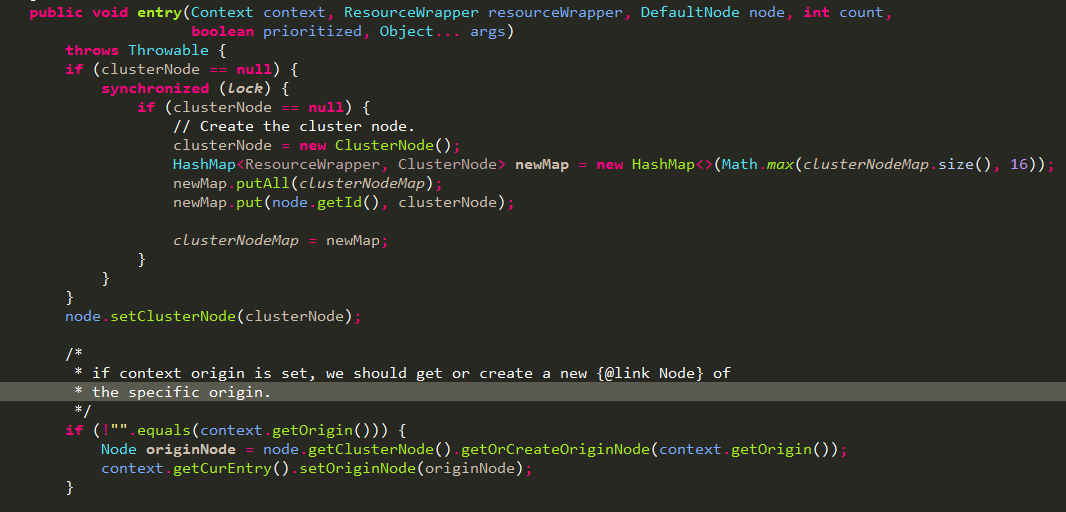
StatisticSlot
核心slot,用于统计各种数据的地方,然后被后面的slot应用。

先调用fireEntry执行后面的slot,检查本次请求能否通过,如果通过,就给对应的node做加法操作。

先给自身node做加法,在给ClusterBuilderSlot中创建并传入的closterNode做加法。
最终调用ArrayMetric的addPass:

需要申明的是,sentinel统计采用的是滑动窗口的实现方式,这里的重点是com.alibaba.csp.sentinel.slots.statistic.base.LeapArray.currentWindow(long)方法,我们看下如何获取当前窗口。
// 根据当前时间戳计算当前窗口的索引
private int calculateTimeIdx(/*@Valid*/ long timeMillis) {
// 索引从0开始,整除后得到的结果就是当前时间戳所在的窗口,实际上我们的窗口只有array长度的固定几个,
// 可以想象一下这是在一个无限延长的虚拟时间线窗口,再对array的length取余数就得到了实际所在的窗口索引 long timeId = timeMillis / windowLengthInMs; // Calculate current index so we can map the timestamp to the leap array. return (int)(timeId % array.length()); } protected long calculateWindowStart(/*@Valid*/ long timeMillis) {
// 计算虚拟窗口对应的开始时间,当前时间减去超出当前窗口的那一段时间就得到开始时间 return timeMillis - timeMillis % windowLengthInMs; } /** * Get bucket item at provided timestamp. * * @param timeMillis a valid timestamp in milliseconds * @return current bucket item at provided timestamp if the time is valid; null if time is invalid */ public WindowWrap<T> currentWindow(long timeMillis) { if (timeMillis < 0) { return null; } // 获取当前窗口索引 int idx = calculateTimeIdx(timeMillis); // Calculate current bucket start time.
// 获取窗口开始时间
long windowStart = calculateWindowStart(timeMillis); /* * Get bucket item at given time from the array. * * (1) Bucket is absent, then just create a new bucket and CAS update to circular array. * (2) Bucket is up-to-date, then just return the bucket. * (3) Bucket is deprecated, then reset current bucket and clean all deprecated buckets. */ while (true) { WindowWrap<T> old = array.get(idx);
// 如果索引对应的窗口还没有创建就新建窗口对象 if (old == null) { /* * B0 B1 B2 NULL B4 * ||_______|_______|_______|_______|_______||___ * 200 400 600 800 1000 1200 timestamp * ^ * time=888 * bucket is empty, so create new and update * * If the old bucket is absent, then we create a new bucket at {@code windowStart}, * then try to update circular array via a CAS operation. Only one thread can * succeed to update, while other threads yield its time slice. */ WindowWrap<T> window = new WindowWrap<T>(windowLengthInMs, windowStart, newEmptyBucket(timeMillis));
// 原子操作,如果设置成功就返回,如果设置失败就让出cpu,等待再次被翻牌 if (array.compareAndSet(idx, null, window)) { // Successfully updated, return the created bucket. return window; } else { // Contention failed, the thread will yield its time slice to wait for bucket available. Thread.yield(); }
// 如果当前窗口时间一致,说明当前窗口还未过期,就返回该窗口对象 } else if (windowStart == old.windowStart()) { /* * B0 B1 B2 B3 B4 * ||_______|_______|_______|_______|_______||___ * 200 400 600 800 1000 1200 timestamp * ^ * time=888 * startTime of Bucket 3: 800, so it's up-to-date * * If current {@code windowStart} is equal to the start timestamp of old bucket, * that means the time is within the bucket, so directly return the bucket. */ return old;
// 如果窗口开始时间过期了,就重置当前窗口的开始时间为最新的时间 } else if (windowStart > old.windowStart()) { /* * (old) * B0 B1 B2 NULL B4 * |_______||_______|_______|_______|_______|_______||___ * ... 1200 1400 1600 1800 2000 2200 timestamp * ^ * time=1676 * startTime of Bucket 2: 400, deprecated, should be reset * * If the start timestamp of old bucket is behind provided time, that means * the bucket is deprecated. We have to reset the bucket to current {@code windowStart}. * Note that the reset and clean-up operations are hard to be atomic, * so we need a update lock to guarantee the correctness of bucket update. * * The update lock is conditional (tiny scope) and will take effect only when * bucket is deprecated, so in most cases it won't lead to performance loss. */ if (updateLock.tryLock()) { try { // Successfully get the update lock, now we reset the bucket. return resetWindowTo(old, windowStart); } finally { updateLock.unlock(); } } else { // Contention failed, the thread will yield its time slice to wait for bucket available. Thread.yield(); }
// 正常情况下不会走这里,因为时间是往前走的 } else if (windowStart < old.windowStart()) { // Should not go through here, as the provided time is already behind. return new WindowWrap<T>(windowLengthInMs, windowStart, newEmptyBucket(timeMillis)); } } }
最终是在MetricBucket中用LongAdder做的原子加,LongAdder是jdk8的特性,这里sentinel直接挪了过来,避免要求sentinel用户必须使用jdk8.为什么是LongAdder而不是AtomicLong,因为前者在并发下表现更优异,具体区别请自行了解。
SystemSlot
通过之前统计节点中Constants.ENTRY_NODE这个node中的数据检查全局qps等是否满足要求。
AuthoritySlot
黑白名单匹配。通过com.alibaba.csp.sentinel.slots.block.authority.AuthorityRuleManager.loadRules(List<AuthorityRule>)设置规则。
FlowSlot
流量控制。通过com.alibaba.csp.sentinel.slots.block.flow.FlowRuleManager.loadRules(List<FlowRule>)设置规则。
DegradeSlot
降级处理。通过com.alibaba.csp.sentinel.slots.block.degrade.DegradeRuleManager.loadRules(List<DegradeRule>)设置规则。


